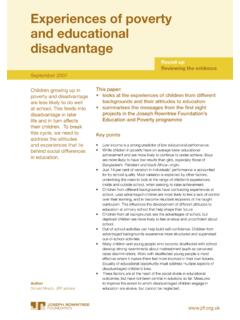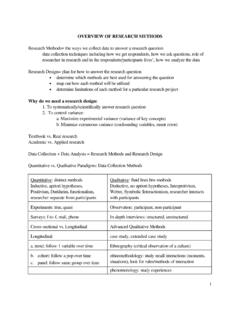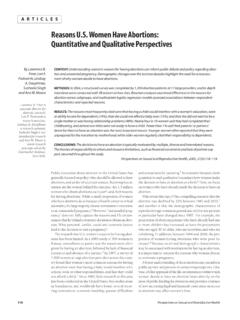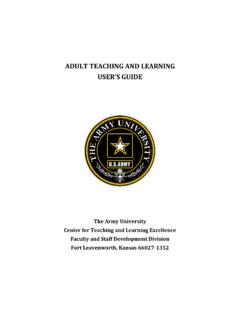Transcription of Using Interviews in a Research Project
1 Trent Focus for Research and Development in Primary Health Care Using Interviews in a Research Project N I G E L M AT H E R S , NICK FOX, AMANDA HUNN. TRENT FOCUS GROUP. Using Interviews in a Research Project AUTHORS: Nigel Mathers, Nick Fox, Amanda Hunn Institute of General Practice Northern General Hospital Sheffield PRODUCED BY: TRENT FOCUS GROUP, 1998. (UPDATED 2002). 1998. Copyright of the Trent Focus Group This resource pack is one of a series produced by the Trent Focus Group. This series has been funded by the Research and Development Group of NHS Executive Trent. This resource pack may be freely photocopied and distributed for the benefit of researchers. However it is the copyright of the Trent Focus Group and the authors and as such, no part of the content may be altered without the prior permission in writing, of the Copyright owner.
2 Reference as: Mathers, Nigel; Fox, Nick and Hunn, Amanda. Trent Focus for Research and Development in Primary Health Care: Using Interviews in a Research Project . Trent Focus, 1998. Using Interviews IN A Research Project . Table of Contents Page Introduction 1. Section 1: Types of interview 2. structured or standardised Interviews Semi- structured Interviews Unstructured or in-depth Interviews Face-to-face Interviews Telephone Interviews Focus group Interviews Section 2: Interviewer Tasks and Skills 5. Locating the respondent Obtaining agreement for the study Asking the questions Recording the answers Section 3: Sources of Error and Bias in Interviewing 8. Section 4: Preparing and Conducting the interview 9. The interview schedule Conducting the interview The pilot study Section 5: Handling interview Data 16.
3 Analysis of quantitative data Analysis of qualitative data Summary 20. Answers to exercises 21. References 23. Further reading and resources 24. Glossary 25. Using Interviews IN A Research Project . Introduction The interview is an important data gathering technique involving verbal communication between the researcher and the subject. Interviews are commonly used in survey designs and in exploratory and descriptive studies. There are a range of approaches to interviewing, from completely unstructured in which the subject is allowed to talk freely about whatever they wish, to highly structured in which the subject responses are limited to answering direct questions. The quality of the data collected in an interview will depend on both the interview design and on the skill of the interviewer.
4 For example, a poorly designed interview may include leading questions or questions that are not understood by the subject. A poor interviewer may consciously or unconsciously influence the responses that the subject makes. In either circumstance, the Research findings will be influenced detrimentally. It is often assumed that if one is clinically trained and used to dealing with patients, that this is sufficient training to carry out Interviews with patients and others for Research purposes. Although there are some areas of overlap in terms of the basic communication skills required, it should be acknowledged that for Research some different skills are required. The context is also important, since in a clinical setting, there is a particular relationship between a patient and clinician.
5 It is possible that in this routine setting the patient would not be prepared to answer all the questions in a completely honest manner. So it may well be worthwhile thinking about the interview from the respondent's point of view and considering carefully who would be the most appropriate person to conduct the interview and in what setting. There may be a conflict of roles, for example, therapeutic versus Research ; or even an unconscious adoption of roles that could affect the quality of the data collected. LEARNING OBJECTIVES. Having successfully completed the work in this pack, you will be able to: Describe the skills required to undertake a structured , semi- structured or unstructured interview . Summarise the advantages and disadvantages of face-to-face and telephone Interviews .
6 Outline the ways in which different types of interview data can be analysed. 1. Using Interviews IN A Research Project . Section 1: Types of interview The interview design and question phrasing will influence the depth and freedom with which a subject can respond. Some Interviews encourage lengthy and detailed replies while others are designed to elicit short and specific responses. The degree of structure imposed on an interview will actually vary along a continuum but it is useful to think of three main types: structured , semi- structured and unstructured. structured or standardised Interviews structured Interviews enable the interviewer to ask each respondent the same questions in the same way. A tightly structured schedule of questions is used, very much like a questionnaire.
7 The questions contained in the questionnaire will have been planned in advance, sometimes with the help of a pilot study to refine the questions. The questions in a structured interview may be phrased in such a way that a limited range of responses is elicited. For example: "Do you think that health services in this area are excellent, good, average or poor? This is an example of a closed question where the possible answers are defined in advance so that the respondent is limited to one of the pre-coded responses. It is not unusual for otherwise structured Interviews to contain a few open-ended questions. Catch-all' final questions are common, for example, Do you have anything more to add?' These questions are useful in helping to capture as much information as possible but they increase the amount of time required for analysing the interview findings.
8 Semi- structured Interviews Semi- structured Interviews involve a series of open-ended questions based on the topic areas the researcher wants to cover. The open-ended nature of the question defines the topic under investigation but provides opportunities for both interviewer and interviewee to discuss some topics in more detail. If the interviewee has difficulty answering a question or provides only a brief response, the interviewer can use cues or prompts to encourage the interviewee to consider the question further. In a semi- structured interview , the interviewer also has the freedom to probe the interviewee to elaborate on the original response or to follow a line of inquiry introduced by the interviewee. An example would be: Interviewer: "I'd like to hear your thoughts on whether changes in government policy have changed the work of the doctor in general practice.
9 Has your work changed at all?". Interviewee: "Absolutely! The workload has increased for a start.". Interviewer: "In what way has it increased?". Semi- structured Interviews are useful when collecting attitudinal information on a large scale, or when the Research is exploratory and it is not possible to draw up a list of possible pre-codes 2. Using Interviews IN A Research Project . because little is known about the subject area. However, analysing the interview data from open questions is more problematic than when closed questions are used as work must be done before often diverse responses from subjects can be compared. well planned and conducted semi- structured Interviews are the result of rigorous preparation. The development of the interview schedule, conducting the interview and analysing the interview data all require careful consideration and preparation.
10 Unstructured or in-depth Interviews Unstructured Interviews (sometimes referred to as "depth" or "in depth" Interviews ) are so called because they have very little structure at all. The interviewer approaches the interview with the aim of discussing a limited number of topics, sometimes as few as one or two, and frames successive questions according to the interviewee's previous response. Although only one or two topics are discussed they are covered in great detail. The interview might begin with the interviewer saying: "I'd like to hear your views on GP commissioning". Subsequent questions would follow from the interviewee's responses. Unstructured Interviews are exactly what they sound like - Interviews where the interviewer wants to find out about a specific topic but has no structure or preconceived plan or expectation as to how the interview will proceed.







